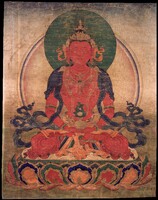Amitayus Buddha Main Page - Updated

Amitabha and Amitayus are the same person, or entity. In the Mahayana Tradition of Buddhism a buddha is described as having three bodies: a form body (nirmanakaya), an apparitional body (sambhogakaya) and an ultimate truth body (dharmakaya). The first, Amitabha, is the form body and the second, Amitayus, is the apparitional body. The ultimate truth body is without appearance and is generally not represented in painting or sculptural art.
The important iconographic difference in Tibetan art between the two, Amitabha and Amitayus, is that Amitabha has Buddha Appearance and Amitayus has Bodhisattva Appearance.
Amitayus, although commonly referred to in the Mahayana literature, is a very popular meditational deity in Vajrayana Buddhism. He belongs to the important and popular set known as the Three Long-life Deities: Amitayus, White Tara and Ushnishavijaya. There are also mandala practices such as the Nine Deity Mandala of Amitayus along with forms of the deity where he is embracing a consort.
Rechungpa, the famous student of Milarepa, recieved a special practice tradition of Buddha Amitayus from Tipu Pandita while on a trip to India. Upon his return he passed the tradition on to Milarepa. This is known as the Rechung Tradition. As a meditational practice in the lower tantras Amitayus primarily serves as a Long-life deity.
